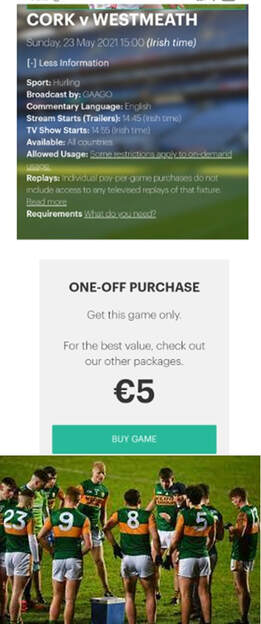
There are other differences between the way sport is broadcast in the US and in Europe. Some are driven by the sporting landscape. American football, baseball, and basketball have many breaks in the activity that make them suitable for commercial TV where adverts can be sold. By contrast, a game of soccer has one scheduled break in the middle of two 45-minute periods of activity. In relative terms, the game is more suitable to subscription TV.
When soccer games returned after the initial lockdown, there was a water-break. The change did not last long and the water break is now gone. The water-break was an opportunity for the game to go to a four-quarter format. That would have been an opportunity for broadcasters to sell advertising. It could also make the game fairer by switching ends at the end of each quarter as in American football.
The water-break remains in GAA games. I presume that in any return to "normality" the water-break will disappear from the game. It is something that should be considered carefully. My proposal would be for four quarters of twenty minutes each (with team swapping ends at each quarter). It is 50 years since the GAA had games that had to last 80 minutes. However, current games last nearly 80 minutes and there is no comparison in the athletes of today and those of the early 1970s. A planned break after every twenty minutes would probably be financial rewarding. It might also help mitigate against some of the weather induced "games of two halves".
Any return to "normality" will probably also change what is offered on the GAA broadcasting landscape. Or maybe not. There has been an evolution in the way GAA games are broadcast. The pandemic has increased the speed of this evolution. But some recently introduced changes might be reversed. At the highest level of the game (inter-county), someone living in Ireland can purchase a subscription to a set of GAA games and/or they can purchase particular games on a pay-per-view basis. When spectators are allowed return to venues to watch games, there might be an inclination to curtail the availability of what can be purchased. Again, I would suggest that some of the changes are retained. Those decision makers, with access to the data on viewership, should evaluate the possibilities.
I have talked to some of those involved below broadcasting/streaming "lower" level games. Those conversations, and the associated viewing figures, suggest that there is an audience for broadcasting/streaming services beyond those who would go to the venues. Again, there is food for thought for those deciding how supporters will be allowed see their teams when crowds return to venues. I will deal with this lower end of GAA broadcasting in a future post.
 RSS Feed
RSS Feed